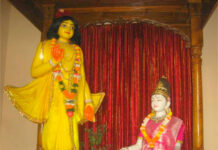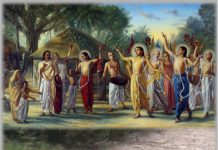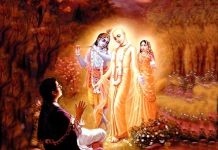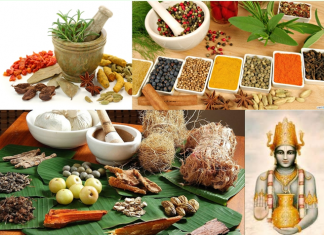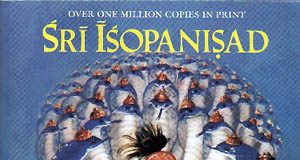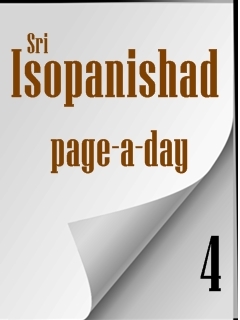
Continued from previous page… He is original, the oldest, but whenever you look at a picture of Krishna you’ll find a young boy fifteen or twenty years old. You will never find an old man. You have seen pictures of Krishna as a charioteer from the Bhagavad-gita. At that time He was not less than one hundred years old. He had great-grandchildren, but He looked just like a boy. Krishna, God, never becomes old. That is His supreme power. And if you want to search out Krishna by studying the Vedic literature, then you will be baffled. It may be possible, but it is very difficult. But you can very easily learn about Him from His devotee. His devotee can deliver Him to you: “Here He is, take Him.” That is the potency of Krishna’s devotees.
Originally there was only one Veda, and there was no necessity of reading it. People were so intelligent and had such sharp memories that by once hearing from the lips of the spiritual master they would understand. They would immediately grasp the whole purport. But five thousand years ago Vyasadeva put the Vedas in writing for the people in this age, Kali-yuga. He knew that eventually the people would be short-lived, their memories would be very poor, and their intelligence would not be very sharp. “Therefore, let me teach this Vedic knowledge in writing.” He divided the Vedas into four: RIg, Sama, Atharva and Yajur. Then he gave the charge of these Vedas to his different disciples. He then thought of the less intelligent class of men—stri, sudra and dvija-bandhu. He considered the woman class and sudra class (worker class) and dvija-bandhu. Dvija-bandhu refers to those who are born in a high family but who are not properly qualified. A man who is born in the family of a brahmana but is not qualified as a brahmana is called dvija-bandhu. For these persons he compiled the Mahabharata, called the history of India, and the eighteen Puranas. These are all part of the Vedic literature: the Puranas, the Mahabharata, the four Vedas and the Upanishads. The Upanishads are part of the Vedas. Then Vyasadeva summarized all Vedic knowledge for scholars and philosophers in what is called the Vedanta-sutra. This is the last word of the Vedas.
Vyasadeva personally wrote the Vedanta-sutra under the instructions of Narada, his Guru Maharaja (spiritual master), but still he was not satisfied. That is a long story, described in Srimad-Bhagavatam. Vedavyasa was not very satisfied even after compiling many Puranas and Upanishads, and even after writing the Vedanta-sutra. Then his spiritual master, Narada, instructed him, “You explain the Vedanta-sutra.” Vedanta means “ultimate knowledge,” and the ultimate knowledge is Krishna. Krishna says that throughout all the Vedas one has to understand Him: vedais ca sarvair aham eva vedyah. Krishna also says, vedanta-krid veda-vid eva caham: “I am the compiler of the Vedanta-sutra, and I am the knower of the Vedas.” Therefore the ultimate objective is Krishna. That is explained in all the Vaishnava commentaries on Vedanta philosophy. We Gaudiya Vaishnavas have our commentary on Vedanta philosophy, called Govinda-bhashya, by Baladeva Vidyabhushana. Similarly, Ramanujacharya has a commentary, and Madhvacharya has one.
The version of Shankaracharya is not the only commentary. There are many Vedanta commentaries, but because the Vaishnavas did not present the first Vedanta commentary, people are under the wrong impression that Shankaracharya’s is the only Vedanta commentary. Besides that, Vyasadeva himself wrote the perfect Vedanta commentary, Srimad-Bhagavatam. Srimad-Bhagavatam begins with the first words of the Vedanta-sutra: janmady asya yatah [SB 1.1.1]. And that janmady asya yatah is fully explained in Srimad-Bhagavatam. The Vedanta-sutra simply hints at what is Brahman, the Absolute Truth: “The Absolute Truth is that from whom everything emanates.” This is a summary, but it is explained in detail in Srimad-Bhagavatam.
If everything is emanating from the Absolute Truth, then what is the nature of the Absolute Truth? That is explained in Srimad-Bhagavatam. The Absolute Truth must be consciousness. He is self-effulgent (sva-rat). We develop our consciousness and knowledge by receiving knowledge from others, but for Him it is said that He is self-effulgent. The whole summary of Vedic knowledge is the Vedanta-sutra, and the Vedanta-sutra is explained by the writer himself in Srimad-Bhagavatam.
We finally request those who are actually after Vedic knowledge to try to understand the explanation of all Vedic knowledge from Srimad-Bhagavatam and the Bhagavad-gita.
(Continue to the next page…)
Source: Sri Isopanishad – Introduction by Srila A.C. Bhaktivedanta Swami Prabhupada. Copyright BBT International http://www.vedabase.com/en/iso
(Delivered as a lecture by His Divine Grace A.C. Bhaktivedanta Swami Prabhupada on October 6, 1969, at Conway Hall, London, England.)


